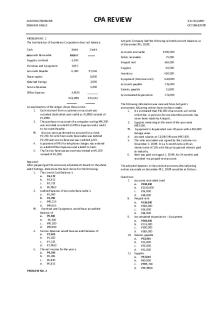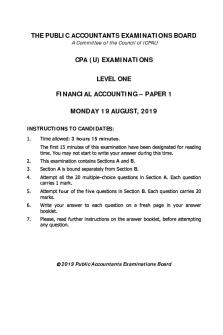CPA - CH 25 - CPA 25 PDF

| Title | CPA - CH 25 - CPA 25 |
|---|---|
| Course | Advanced Accounting |
| Institution | Gonzaga University |
| Pages | 2 |
| File Size | 34.6 KB |
| File Type | |
| Total Downloads | 43 |
| Total Views | 170 |
Summary
CPA 25...
Description
ACCT 2020 – Oxley CPA – CH 25 1. How do you define differential analysis and differential revenue? Differential analysis: compute all costs associated with each alternative, ignore the sunk costs, ignore costs that remain largely constant among the alternatives, and select the alternative offering the best cost-to-benefit ratio. Differential revenue: the difference in sales that will be generated by two different courses of action. 2. How do you define differential cost and differential income (loss)? Differential income is the change in income compared with the change in income for another project or investment. Differential cost is the difference between the cost of two alternative decisions, or of a change in output levels. 3. What are the six decisions differential analysis is used for in this chapter? Leasing or selling equipment, discontinuing an unprofitable segment, manufacturing or purchasing a needed part, replacing fixed assets, selling a product or processing further, accepting additional business at a special price 4. What is the definition of an opportunity cost? The amount of income waived from an alternative to a proposed use of cash. 5. What are the two market methods used to determine selling price and how do they work? 6. What are the three cost plus methods to determine selling price? Product cost concept, total cost concept, and variable cost concept. 7. What are the six steps used in the product cost concept? Estimate the total product costs, estimate the total selling and administration expenses, divide, compute the markup percent, determine the markup per unit, and determine the normal selling price. 8. What is target costing and how does it affect overall costs? Target costing is a method of setting prices that combines market-based pricing with a cost-reduction emphasis it reduces overall costs. 9. In a production bottleneck operation what is the best measure of activity? The unit contribution margin or the unit contribution margin per production bottleneck constraint? Why? The best measure of profitability is the unit contribution margin per production bottleneck constraint. 10. When is Activity-based costing (ABC) more appropriate than using one predetermined factory overhead rate as discussed in chapter 19?
ABC method is more appropriate to use for allocating factory overhead when there are diverse products and processes because one predetermined factory overhead rate will distort factory overhead allocation....
Similar Free PDFs

CPA - CH 25 - CPA 25
- 2 Pages

Rmk audit ch 25
- 7 Pages

CPA Syllabus
- 67 Pages

Ch 25 - Test bank
- 18 Pages

Ch. 25 Notes
- 3 Pages

Cpa 20 2016 fevereiro - CPA 20
- 203 Pages

Strategies:Aims Axis #HSC 25:25
- 4 Pages

Invisible Man Ch.25 Analysis
- 3 Pages

CPA08 - CPA 8 - Gillette
- 2 Pages

E2105 CPA Ch4 F
- 2 Pages

Ch25 - Lecture notes ch 25
- 20 Pages

AUDITING PROBLEMS (CPA REVIEW)
- 7 Pages

Document - CPA reviewer
- 11 Pages
Popular Institutions
- Tinajero National High School - Annex
- Politeknik Caltex Riau
- Yokohama City University
- SGT University
- University of Al-Qadisiyah
- Divine Word College of Vigan
- Techniek College Rotterdam
- Universidade de Santiago
- Universiti Teknologi MARA Cawangan Johor Kampus Pasir Gudang
- Poltekkes Kemenkes Yogyakarta
- Baguio City National High School
- Colegio san marcos
- preparatoria uno
- Centro de Bachillerato Tecnológico Industrial y de Servicios No. 107
- Dalian Maritime University
- Quang Trung Secondary School
- Colegio Tecnológico en Informática
- Corporación Regional de Educación Superior
- Grupo CEDVA
- Dar Al Uloom University
- Centro de Estudios Preuniversitarios de la Universidad Nacional de Ingeniería
- 上智大学
- Aakash International School, Nuna Majara
- San Felipe Neri Catholic School
- Kang Chiao International School - New Taipei City
- Misamis Occidental National High School
- Institución Educativa Escuela Normal Juan Ladrilleros
- Kolehiyo ng Pantukan
- Batanes State College
- Instituto Continental
- Sekolah Menengah Kejuruan Kesehatan Kaltara (Tarakan)
- Colegio de La Inmaculada Concepcion - Cebu


